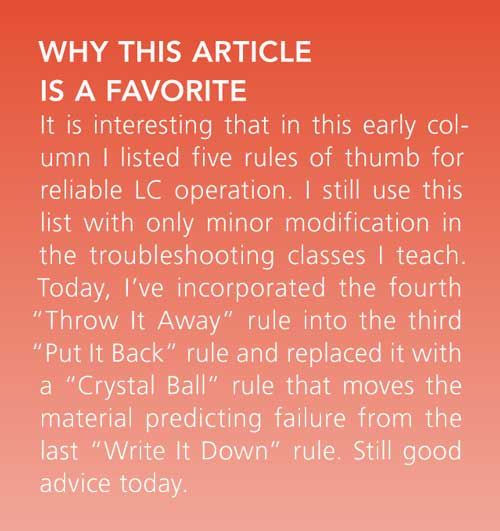Rules of Thumb
Special Issues
Here are five ideas to help avoid common problems.
Here are five ideas to help avoid common problems.
When I give lectures and short courses on LC troubleshooting, I am often asked to distill a day’s lectures into a few salient points that users can tuck away in a corner of their brains for future reference. Essentially, I’ve come up with five “rules of thumb.” I jokingly dedicate them to those of us who are “all thumbs” in the lab; however, all of us, beginners and experienced chromatographers alike, can benefit by incorporating these practices into our daily lab routines.

Rule of One
The “Rule of One” reminds us to change only one thing at a time when isolating an LC problem. It is odd that while the scientific method is rigorously practiced in many areas of the lab, it is often ignored when it comes to troubleshooting. For example, if excessive peak broadening is observed, there are several possible causes, including problems with the guard column, the analytical column, and the mobile phase. Too often, the reasoning goes like this: “Well, the guard column is due for a change, and I can’t remember how long I’ve been using that analytical column. Oh, and that’s yesterday’s mobile phase.” So all three things are changed simultaneously, and the symptoms of the problem disappear. Is the problem solved? Yes . . . and no. Yes, the symptoms have disappeared, and LC operation can continue. No, we don’t have further information that can help us prevent or anticipate the problem in the future.
Rarely is an LC problem the result of more than one cause. Troubleshooting efforts should therefore be directed at isolating the single problem source. That way, the true cause of the problem can be located and corrected. When you use this approach, you will find that you get longer lifetimes out of columns and other components that were previously replaced without sufficient evidence of failure. The “Rule of One” reminds us that in the long run we can save time and money by isolating problems systematically.
Rule of Two
The “Rule of Two” states that a problem really isn’t a problem until it occurs at least twice. Although we would like to think of LC systems as being reliable and reproducible, one-time problems abound. One example is the occurrence of a baseline spike in the chromatogram resulting from an air bubble passing through the detector cell. There are many possible reasons for air bubbles in the detector, including poorly degassed mobile phase, an improperly purged column, air leaks, or injection problems. Experience has shown, however, that no matter how carefully we exclude air from the system, microbubbles still get into the detector. These microbubbles eventually coalesce, and a bubble passes through the cell, causing a baseline spike. A bubble spike once a day or once a week may be irritating, but it is not worth spending time to eliminate. If you wait until the problem occurs more often (for example, several times per hour) to correct it, you will probably have a clearer idea of where the problem lies, and therefore save hours of troubleshooting time.
Many one time problems, such as interferences, double peaks, and baseline drift, are related to individual samples. Occasional baseline noise can result from bubbles, from electrical apparatus in the lab, or from real problems such as detector lamp failure or data-system malfunction. There should be a definite cause-and-effect relationship between the problem and the corrective action. The “Rule of Two” reminds us to confirm that a problem really exists before we try to solve it.
Put It Back
The purpose of this rule is to help conserve resources and avoid future problems. Substituting known good parts is often the most effective way to isolate an LC problem. The “Put It Back” rule tells us to reinstall the old part if the substituted good part does not solve the problem. An example of this is the isolation of electronics problems. While most electronics problems are beyond the troubleshooting skills of the average chromatographer, substituting circuit boards is a simple way to isolate many electronic disorders. Questionable boards are swapped, one at a time, with good ones from another unit or from a spare parts supply. Once the problem board is found, all the other boards should be replaced with the originals. This practice avoids the accumulation of parts of questionable quality. It is especially important to apply this rule to columns and electronic parts, which cannot be visually inspected for quality.
As with every rule, the “Put It Back” rule has exceptions. Use common sense, and the exceptions should be clear. If the part is inexpensive or is replaced regularly anyway, there is little point in putting an old part back. Such parts include column frits and guard columns. Other parts, such as pump seals, are generally damaged when they are removed, so of course, you shouldn’t reinstall them.
Throw It Away
Hand in hand with the “Put It Back” rule is the “Throw It Away” rule. If you have removed a defective part from the LC system, throw it away so that it doesn’t get mixed up with good parts. If you decide to keep a used part, label it with its history, so you have a basis for screening its usefulness in the future. Every lab has a drawer full of used columns, saved “just in case.” The columns are rarely, if ever, used because nobody trusts them. This situation could be improved if the truly bad columns were discarded and the ones with remaining life were clearly labeled.
Write It Down
It would be very nice if every LC system came with a crystal ball that could tell what component would fail next and when. That will never happen, but the crystal ball really isn’t needed in the lab where good preventative maintenance and record-keeping are practiced. For routine assays, you should know about how many injections you can get from a column or guard column. Once you know that, you can minimize problems in one of two ways. First, you can replace the part before it fails. This is practical for inexpensive parts, such as guard columns; throwing away a nearly spent guard column is less expensive than replacing an analytical column after contaminants break through from the guard column. Second, for more expensive parts such as analytical columns and, perhaps, detector lamps, you may choose to operate the part until failure occurs and then replace it. Troubleshooting will be minimized, however, if you use good preventative maintenance and record-keeping. For example, if you know that you get about six months of service from a detector lamp, you can be on the lookout for early signs of lamp failure and have a spare on hand. Thus, when you see noise spikes or a noisy baseline after five or six months of use, you can be prepared for the failure, and downtime will be minimal.
What areas should you monitor? These have been discussed before (see reference 1), but they’re worth reviewing. Solvent inlet-line frits have a finite lifetime (one to six months) before they become blocked; useful lifetimes are shorter when buffered mobile phases are used. Pump seals may last up to a year, again depending on buffer usage. Guard columns will last a day, a week, or a month, depending on how clean the samples are. Analytical columns are good for 100 to more than 1000 samples, depending on sample cleanliness and guard column usage. Detector lamps last from 3 to 12 months in most cases. In addition, keep an eye on the level of solvent in the reservoirs, how much chart paper is left on your data system, the air pressure to an automatic valve, and any other system specific items that must be replenished regularly. [Note that at one time all data systems had strip-chart printouts and that injection valves were operated on air pressure instead of an electric actuator.]
To establish failure patterns and component lifetimes, you must have an adequate set of records for reference. Each lab has different record-keeping requirements, especially for instrument maintenance. If you don’t have an established practice, I suggest keeping a dedicated notebook near each LC system and writing down information about any maintenance or troubleshooting done on the system. These notes don’t have to be extensive to be useful: include the date, the operator’s name, the failure symptom, the fix, and any other pertinent information. You should keep track of the approximate number of samples run and any unusual samples or mobile phases that might stress the system. Whether the system is operated by one or by several users, in a few months time you will find that the contents of this notebook can help you design a preventive maintenance program. If you aren’t keeping maintenance and troubleshooting records on each LC system, start today. These records won’t be very useful for the first couple of months, but after that you’ll begin to see failure patterns. Then you will be able to avoid, or at least anticipate, the most common areas of failure for your LC system.
Do It Right the First Time
Practicing these five rules of thumb will reduce the amount of time you spend repairing your LC system. The saying “There’s never time to do it right, but there’s always time to do it over” should not reflect your attitude toward troubleshooting and preventive maintenance. While it has become common in some labs to ignore maintenance because of pressures for sample throughput or other measures of productivity, the practice of waiting until the LC system is broken, then replacing parts in a haphazard fashion is always more expensive (in time and materials) than practicing the rules of thumb presented here. Anticipated problems usually can be fixed on your schedule (for example, at the beginning or end of a shift). Unexpected failure, on the other hand, often requires more extensive problem isolation, correction of secondary problems caused by the primary failure, and reinjection of questionable samples. This all adds up to greater downtime.
References
- J.W. Dolan, LC•GC5, 24–26 (1987).
How to Cite This Article
J.W. Dolan, LC•GC6(4), 304–308 (1988).

A Matrix-Matched Semiquantification Method for PFAS in AFFF-Contaminated Soil
Published: April 14th 2025 | Updated: April 14th 2025Catharina Capitain and Melanie Schüßler from the Faculty of Geosciences at the University of Tübingen, Tübingen, Germany describe a novel approach using matrix-matched semiquantification to investigate per- and polyfluoroalkyl substances (PFAS) in contaminated soil.
Silvia Radenkovic on Building Connections in the Scientific Community
April 11th 2025In the second part of our conversation with Silvia Radenkovic, she shares insights into her involvement in scientific organizations and offers advice for young scientists looking to engage more in scientific organizations.














